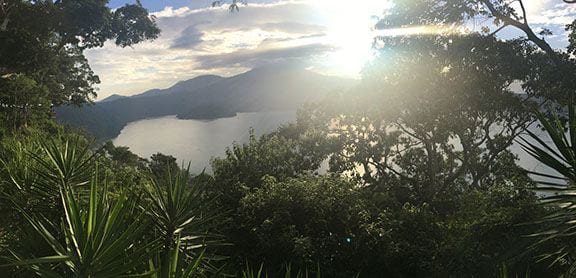IMAGE OF THE WEEK
 Ruchi Patel shares this photo she took while conducting fieldwork in El Salvador this summer. Lago de Coatepeque is a large crater lake in the east part of the Coatepeque Caldera.
Ruchi Patel shares this photo she took while conducting fieldwork in El Salvador this summer. Lago de Coatepeque is a large crater lake in the east part of the Coatepeque Caldera.
GOOD NEWS
Melissa Lucash, Department of Geography, Portland State University, will give a talk on “Forest resilience under climate change: Tales from the boreal forests of Alaska and beyond,” on Wednesday, September 26, 9:00 to 10:00 a.m. in 117 EES Building. The talk is co-sponsored by the Center for Landscape Dynamics and the Center for Climate Risk Management.
Supporting Women in Geography is hosting a “Climate Change Workshop” on November 9, from noon to 3:00 p.m. in 529 Walker Building, University Park campus. Anyone with interest in the topic is invited to attend, however you must register as seating is limited. For more information and to register visit: https://www.geog.psu.edu/event/climate-change-workshop
NEWS
Please join us for a special Coffee Hour in Memory of Peirce Lewis on October 5
Colleagues, friends, family, and students of the late Geographer Peirce Lewis are invited to join us as the Department of Geography pays tribute to the man and his contributions to geography. Richard Schein (’83g), Peirce Lewis’s advisee and now professor of geography at the University of Kentucky, will give the Coffee Hour lecture. For more information about the program or to RSVP by September 28 visit: https://www.geog.psu.edu/event/coffee-hour-richard-schein
Penn State GIS Day: Visualizing the World: Connecting the disciplines through geospatial technologies and virtual reality
Penn State GIS Day events will be held on Tuesday, November 13. Penn State GIS Day events are co-sponsored by the Department of Geography and the University Libraries.
Penn State GIS Day events aim to create geospatial awareness of the many uses of geospatial technologies across disciplines, and serve as a way to connect others on campus who are using geospatial technologies.This year marks the fifth consecutive year we have been sponsoring GIS Day events. This year’s theme is: Visualizing the World: Connecting the disciplines through geospatial technologies and virtual reality.
See the Penn State GIS Day site for listings of speakers and additional information. https://sites.psu.edu/gisday/
Marion Frieswyk: The First Female Intelligence Cartographer
For 75 years, the CIA Cartography Center has been making vital contributions to our Nation’s security, providing policymakers with crucial insights that simply cannot be conveyed through words alone.
The Center’s roots stretch back even before the Office of Strategic Services (OSS)—all the way to the OSS’ predecessor, William Donovan’s Office of the Coordinator of Information (COI).
RECENTLY PUBLISHED
Human Legacies on Ecological Landscapes
Mitchell J. Power, Brian F. Codding, Alan H. Taylor, Thomas W. Swetnam, Kate E. Magargal, Douglas W. Bird and James F. O’Connell
Frontiers in Earth Science
https://www.frontiersin.org/article/10.3389/feart.2018.00151
The primacy of past human activity in triggering change in earth’s ecosystems remains a contested idea. Treating human-environmental dynamics as a dichotomous phenomenon—turning “on” or “off” at some tipping point in the past—misses the broader, longer-term, and varied role humans play in creating lasting ecological legacies. To investigate these more subtle human-environmental dynamics, we propose an interdisciplinary framework, for evaluating past and predicting future landscape change focused on human-fire legacies. Linking theory and methods from behavioral and landscape ecology, we present a coupled framework capable of explaining how and why humans make subsistence decisions and interact with environmental variation through time. We review evidence using this framework that demonstrates how human behavior can influence vegetation cover and continuity, change local disturbance regimes, and create socio-ecological systems that can dampen or even override, the environmental effects of local and regional climate. Our examples emphasize how a long-term interdisciplinary perspective provides new insights for assessing the role of humans in generating persistent landscape legacies that go unrecognized using a simple natural-versus-human driver model of environmental change.
Farm-Level Agricultural Biodiversity in the Peruvian Andes Is Associated with Greater Odds of Women Achieving a Minimally Diverse and Micronutrient Adequate Diet
Andrew D Jones, Hilary Creed-Kanashiro, Karl S Zimmerer, Stef de Haan, Miluska Carrasco, Krysty Meza, Gisella S Cruz-Garcia, Milka Tello, Franklin Plasencia Amaya, R Margot Marin, Lizette Ganoza
The Journal of Nutrition
https://doi.org/10.1093/jn/nxy166
The extent to and mechanisms by which agricultural biodiversity may influence diet diversity and quality among women are not well understood. We aimed to 1) determine the association of farm-level agricultural biodiversity with diet diversity and quality among women of reproductive age in Peru and 2) determine the extent to which farm market orientation mediates or moderates this association. We surveyed 600 households with the use of stratified random sampling across 3 study landscapes in the Peruvian Andes with diverse agroecological and market conditions. Diet diversity and quality among women were assessed by using quantitative 24-h dietary recalls with repeat recalls among 100 randomly selected women. We calculated a 10-food group diet diversity score (DDS), the Minimum Dietary Diversity for Women (MDD-W) indicator, probability of adequacy (PA) of 9 micronutrients by using a measurement-error model approach, and mean PA (MPA; mean of PAs for all nutrients). Agricultural biodiversity was defined as a count of crop species cultivated by the household during the 2016–2017 agricultural season. In regression analyses adjusting for sociodemographic and agricultural characteristics, farm-level agricultural biodiversity was associated with a higher DDS (incidence rate ratio from Poisson regression: 1.03; P < 0.05) and MPA (ordinary least-squares β-coefficient: 0.65; P < 0.1) and higher odds of achieving a minimally diverse diet (MDD-W: OR from logistic regression: 1.17; 95% CI: 1.11, 1.23) and a diet that met a minimum threshold for micronutrient adequacy (MPA >60%: OR: 1.21; 95% CI: 1.10, 1.35). Farm market orientation did not consistently moderate these associations, and in path analyses we observed no consistent evidence of mediation of these associations by farm market orientation.
